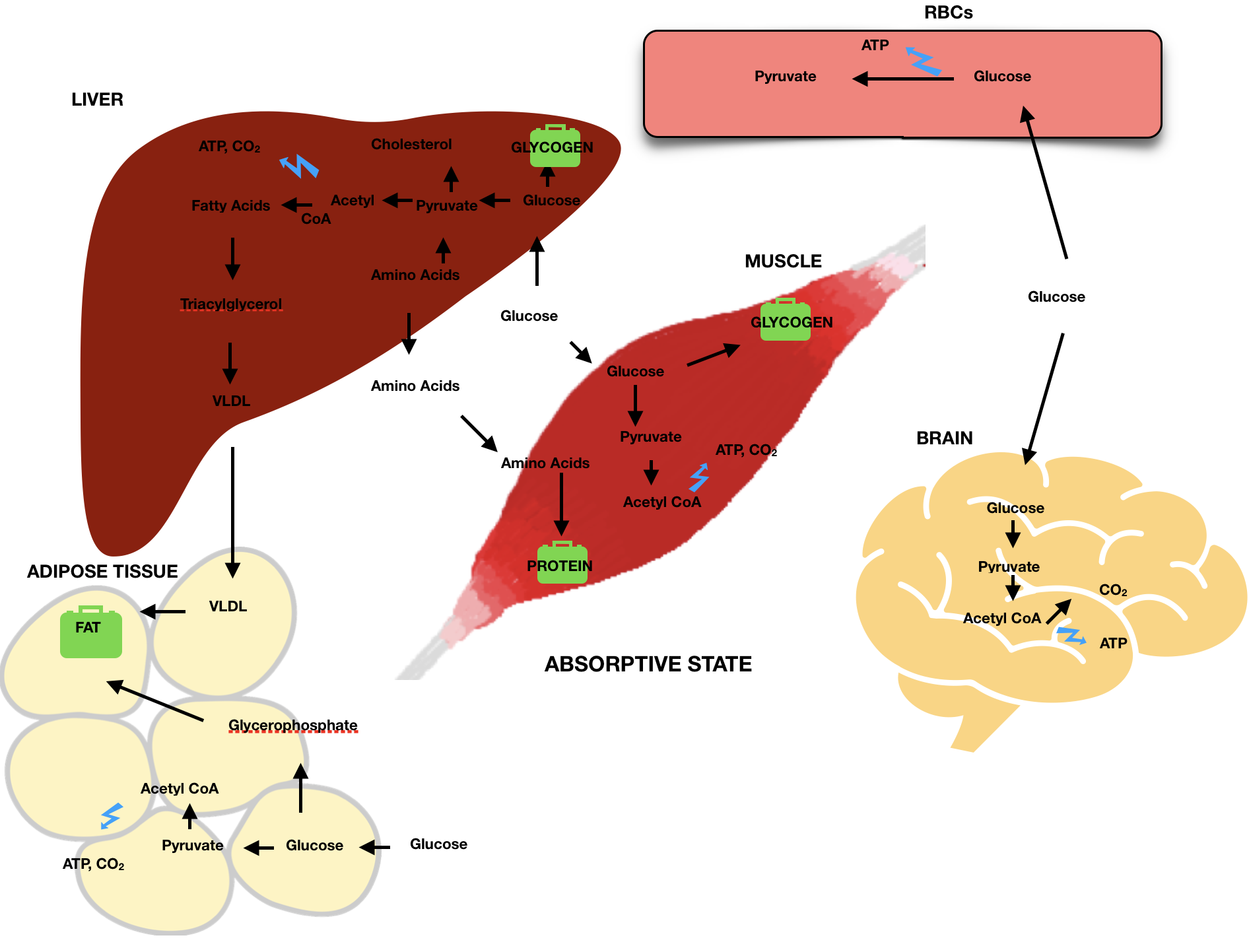Fuel Metabolism - The 'switch' between Fasting and Well-fed states
“You are what you eat."
A common proverb, but brimmed with more meaning than the obvious.
Although we consume periodically throughout the day, the human body requires a constant supply of glucose, which it uses as energy or metabolic fuel. The body processes food for immediate energy use, and stores it for later use such as periods of fasting, exercise or starvation.
There are two physiological states of fuel metabolism that we will discuss:
The Absorptive State
The Post-absorptive State
Now lets dig in.
The absorptive state, or well-fed state, starts immediately after a meal consumption. Digestion begins in the mouth, where saliva begins to break down carbohydrates into smaller components. Carbohydrate digestion continues in the stomach and small intestines, along with protein and fat digestion. The broken down constituents (from carbohydrates, fats and proteins) are then transported across the intestinal wall and enter the bloodstream. They are taken up by the liver, skeletal muscle cells and adipose tissue for energy use and for storage.
After food, the increase in glucose levels in the portal blood stimulates the pancreatic beta cells to release insulin. Insulin is one of two hormones which is key to our discussion of the body’s fuel metabolism; the other hormone being glucagon (discussed later). What are insulin’s actions? It allows for the absorption of glucose into liver, muscle and adipose cells. As glucose enters the hepatic cells, it is converted into glucose-6-phosphate (by enzyme glucokinase), and generates a concentration gradient with a higher glucose concentration in the blood than in the cells. This gradient permits more glucose to be absorbed. In addition, insulin stimulates the production of glycogen (glycogenesis), which is the storage form of glucose, in the liver and the muscle cells.
Once glycogen stores are filled, insulin stimulates triglyceride and protein synthesis. Glucose undergoes glycolysis to form pyruvate, which is metabolized into Acetyl CoA by the action of enzyme pyruvate dehydrogenase. Acetyl CoA is integral in the synthesis of fatty acids, cholesterol and ultimately triglycerides (lipogenesis) in adipose tissue. In muscle, along with glycogen synthesis, insulin stimulates amino acid uptake by the cells and ultimately stimulates protein synthesis.
The second state is called the post-absorptive state, also known as the fasting state, which occurs after the food has been ingested, digested, absorbed and stored (usually during an overnight fast). The hormone glucagon released by the pancreatic alpha cells is integral during this state of metabolism. Glucagon levels rise (due to decreased glucose levels in portal blood) in order to stabilize blood glucose levels for supply to the body and its organs. Similar to insulin, glucagon exerts its effect on liver, muscle and adipose tissue (but in an opposite manner).
In the liver, glucagon stimulates glycogen degradation into glucose (glycogenolysis) and release of glucose into the blood for use by other body organs (most importantly, the brain). Once glycogen stores are depleted, glucagon stimulates gluconeogenesis (formation of glucose) from substrates such as Glycerol-3-Phosphate, Lactate and Gluconeogenic amino acids (alanine and glutamine). Due to decrease in pyruvate levels (used in gluconeogenesis), fatty acid synthesis is consequently reduced. In addition, the liver has a large capacity for Beta-Oxidation, as it forms Acetyl CoA at a quantity greater than its oxidizing potential. The Acetyl CoA is used to synthesize ketone bodies, which can also be used as metabolic fuel for skeletal muscle, cardiac muscle and brain tissue.
In adipose tissues and skeletal muscles, glucagon stimulates release of fatty acids and amino acids into the blood, respectively. By the action of epinephrine (catecholamine), the circulating amino acids and fatty acids are taken up by the liver for gluconeogenesis, thereby increasing increasing blood glucose levels.
An exception to these two states: The brain and Red Blood Cells.
The brain derives its energy by the the oxidation of glucose into carbon dioxide and water (Under BOTH Absorptive and Non-absorptive States). In prolonged fasting/starvation, the brain adapts by utilizing ketones as its prime energy source.
The Red Blood Cells derive energy anaerobically ONLY through glycolysis (under ALL conditions).
Author: Sangeethabalasri Pugazhendhi
Sources and citations
Rodwell, Victor W. et al. Harper's Illustrated Biochemistry. 30th ed., McGraw-Hill Education, 2018.


